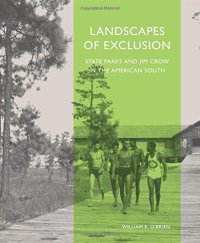
Ebook: Landscapes of Exclusion: State Parks and Jim Crow in the American South
Author: William E. O’Brien
- Tags: Landscape, Architecture, Arts & Photography, Africa, Algeria, Egypt, Ethiopia, Kenya, Nigeria, South Africa, Sudan, Zimbabwe, History, United States, African Americans, Civil War, Colonial Period, Immigrants, Revolution & Founding, State & Local, Americas, History, Asia, China, Hong Kong, India, Japan, Korea, Pakistan, Philippines, Russia, History, African-American Studies, Specific Demographics, Social Sciences, Politics & Social Sciences, Cultural, Anthropology, Politics & Social Sciences
- Series: Designing the American Park
- Year: 2015
- Publisher: University of Massachusetts Press
- Language: English
- pdf
From early in the twentieth century, the state park movement sought to expand public access to scenic American places. During the 1930s those efforts accelerated as the National Park Service used New Deal funding and labor to construct parks nationwide. However, under severe Jim Crow restrictions in the South, African Americans were routinely and officially denied entrance to these sites. In response, advocacy groups pressured the National Park Service to provide some facilities for African Americans. William E. O'Brien shows that these parks were typically substandard in relation to "white only" areas.
In the postwar years, as the NAACP filed federal lawsuits that demanded park desegregation and increased pressure on park officials, southern park agencies reacted with attempts to expand segregated facilities, hoping they could demonstrate that these parks achieved the "separate but equal" standard. But the courts consistently ruled in favor of integration, leading to the end of segregated state parks by the middle of the 1960s. Even though the stories behind these largely inferior facilities faded from public awareness, the imprint of segregated state park design remains visible throughout the South.
O'Brien illuminates this untold facet of Jim Crow history in the first-ever study of segregation in southern state parks. His new book underscores the profound inequality that persisted for decades in the number, size, and quality of state parks provided for African American visitors in the Jim Crow South.
In the postwar years, as the NAACP filed federal lawsuits that demanded park desegregation and increased pressure on park officials, southern park agencies reacted with attempts to expand segregated facilities, hoping they could demonstrate that these parks achieved the "separate but equal" standard. But the courts consistently ruled in favor of integration, leading to the end of segregated state parks by the middle of the 1960s. Even though the stories behind these largely inferior facilities faded from public awareness, the imprint of segregated state park design remains visible throughout the South.
O'Brien illuminates this untold facet of Jim Crow history in the first-ever study of segregation in southern state parks. His new book underscores the profound inequality that persisted for decades in the number, size, and quality of state parks provided for African American visitors in the Jim Crow South.
Download the book Landscapes of Exclusion: State Parks and Jim Crow in the American South for free or read online
Continue reading on any device:

Last viewed books
Related books
{related-news}
Comments (0)